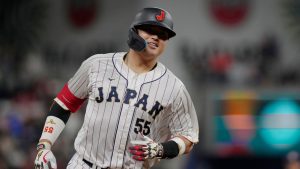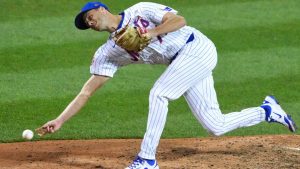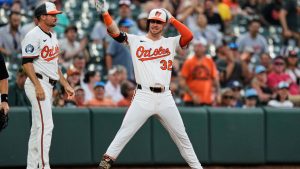TORONTO — Much like the off-season, the lead-up to the trade deadline and the strategic posturing inherent to it can make it difficult to separate fact from fiction. The Toronto Blue Jays are right in the middle of that vortex, so with four weeks before the July 30 cutoff, here’s a look at some of the conversations fans and people in the baseball industry are having about them:
The season is already over
Math doesn’t lie, and with playoff odds of 4.2 per cent, as calculated by FanGraphs, it’s pretty clear that barring an absurdly-off-the-charts turnaround, the Blue Jays won’t be playing October baseball.
Now, that’s a reality for the front office to acknowledge and manage through while mapping out a trade-deadline strategy, even if it’s one Blue Jays players steadfastly reject each time they take the field. No matter the odds, players are wired to believe they’re one hot streak away from turning things around, especially in a league filled with mid-teams chasing the second and third wild cards.
Playoff odds, after all, aren’t static, they fluctuate based on ever-changing inputs and can change quickly. At the same time, the mounting injuries facing the Blue Jays — Isiah Kiner-Falefa’s placement on the injured list with a left knee sprain likely to sideline him into August is the latest hit — only make the road that much tougher. There’s nothing wrong with playing things out while simultaneously working on parallel tracks, which is what the Blue Jays are doing, even though a partial sell is nearly inevitable.
The players have given up
The results this year have been frustrating, for sure. A lot of games have been tough to watch. And the Groundhog Day feel on so many nights certainly adds to the above perception.
But Blue Jays players have absolutely not surrendered and are grinding daily, even if the results don’t always match the effort. If you want to see what it looks like when a team has pulled the chute on a season, remember the end of the Blue Jays seasons in 2012 (22-37 through the final two months) and 2013 (34-47 over final three months), when bad seasons got really ugly.
Could something similar happen again this summer after the trade deadline? It’s possible, which is why the club setting a direction for next year is so important. Once the Blue Jays sell, the 2025 season in a sense needs to start, with players getting an early jump on winning their spots for next year while building a culture that carries over. If no positives come from August and September, that would compound the damage of this season.
Trade everyone
There’s merit in debating how far a rebuild should go. We’ll kick that around a bit further down. But if you’re on Team Blow It All Up, are you sure you’re ready for all that entails? Remember that 95-loss mess of 2019? You want to do that times two or three, without a guarantee that you’ll successfully emerge from the morass a well-oiled machine like the Baltimore Orioles?
Rebuilds are a last resort for barren-wasteland organizations — hey there, Chicago White Sox — and, as one rival executive pointed out, teams with the financial resources the Blue Jays have, spending beyond the Competitive Balance Tax threshold of $237 million this season, shouldn’t need to go down that road.
The primary challenge in rebuilding is in re-creating the talent you’re trading away, which is why there’s a case for augmenting around this core instead. Worth remembering is, more often than not, the prospects subtraction deals return do not pan out, meaning the selling team is usually giving up the best player in the trade, with no guarantee of value, let alone equal value, in return.
'There’s obviously the opportunity to extend (Bo and Vlad)'
Blue Jays general manager Ross Atkins said this during a June 27 appearance on Blair and Barker in reference to the club’s two superstars, Bo Bichette and Vladimir Guerrero Jr., who are both eligible for free agency after the 2025 season. Earlier that day, while speaking during a media availability, Atkins said making this Blue Jays team sustainable “has to be something that we continue to build from within and think about potential extensions.”
If you’re on Team Keep It Together, sounds great, right?
In theory, sure, but this isn’t an easy time to get extensions done. For the club’s pending free agents, the market beckons and there isn’t much incentive to negotiate with only one team when, in three months, you can negotiate with 30. There’s also a question of what exactly you’d be signing up for next year, depending on the direction this team goes.
All that applies with exponents to Guerrero and Bichette, exactly the calibre of player the Blue Jays will be seeking to acquire, should they split with the duo. Neither has performed anywhere near to peak and their games get picked apart regularly, but as one player said to me recently, “These guys are five seasons in at 25 and 26 while Aaron Judge only debuted at 24, and it took him a few years to become what he is today. Give them the same time and they can be that good, too.”
That makes sense and the nightmare scenario for this organization is that Guerrero and Bichette spend their peak years mashing with other teams while the Blue Jays struggle to find new cornerstones. All the more reason an extension makes so much sense.
The problem is in finding the sweet spot between the players, who have no reason to demand anything less than full value and will want to see Juan Soto reset the market this winter, and the team, which has reason to be wary of paying market price at this point.
There’s little chance the Blue Jays get enough back in a trade to justify dealing them — rival teams are reading the situation, too, and aren’t going to pony up franchise-altering prospects, while the Blue Jays can’t afford the optics of a bad return — so you have the frustrating stalemate playing out right now.
Both players also want to be in winning environments, so they’d want to see a reasonable pathway back to contending, adding yet another layer to the mix. All of which points to the Blue Jays running it back with both next year without an extension in place, each side hoping circumstances shift advantageously in their favour, or force them together.
This is all John Schneider’s fault
Managers often take the heat in these situations but the question worth asking is that if whoever you think is the best manager in baseball was running the Blue Jays instead of John Schneider, would things be any different?
Neither Dave Roberts nor Bruce Bochy, nor Kevin Cash, nor Brian Snitker nor insert name here is making more out of a bullpen down four of its five highest-leverage relievers. None of them are making Kevin Gausman’s splitter more consistent or keeping Alek Manoah from blowing out his elbow. None of them are getting more from the offence, although after a deep dive into the hitting all winter, why it’s only started to come around recently is a question in need of another internal audit.
Schneider has done his best under difficult circumstances. He’s shown loyalty to his veteran players by sticking with them through extended slumps. He’s been aggressive in trying new things when that doesn't work. He’s played hot hands when, at times, the numbers might have dictated otherwise. While the Blue Jays are duty-bound to examine whether a different kitchen staff is necessary once the season ends, a chef can only cook with the ingredients provided.
This is all Ross Atkins’ fault
Front-office decisions are never made by one person, especially in the Blue Jays’ highly collaborative structure, so pinning this season on one person alone is impossible.
But Atkins is, ostensibly, the chief baseball decision-maker who is now in his ninth season as GM. When he took over, he inherited a playoff-bound team facing major headwinds but with Guerrero in the system, and now he’s overseeing a team set to miss the playoffs facing major headwinds without a future cornerstone in the system.
Coming out of the 2020 season, the Blue Jays were viewed within the industry as a sustainably built powerhouse and four years later, the roster is timing out, the farm system isn’t deep enough to replenish the core and the division has surpassed them. Meanwhile, rival executives have been circling overhead like vultures since spring training, looking to pick off players from the roster’s carcass.
It shouldn’t be lost that the Blue Jays faced more challenges than most during the pandemic and their best team of this cycle, the 2021 group that missed the playoffs by one game, had to play home games in three separate cities. That’s a haunting missed opportunity for the franchise, second only to final-week collapse of 1987, both teams that deserved October’s stage.
It didn’t happen, the Blue Jays are where they are and the organization is arriving at pivotal inflection point. During that media availability on June 27, Atkins said “the fact that we are in this position squarely lies with me, I'm accountable for that,” and once the deadline passes, he’ll have to be.
The Blue Jays can’t easily reset and be competitive in 2025
This really should be the key discussion right now in the Blue Jays front office: if they only sell-off expiring contracts with an eye toward resetting in 2025, what are they going to do to really make that worthwhile?
The worst thing they can do right now is hold on to their assets and then tepidly build around the group for next year, setting up another season like this one. That’s what the Blue Jays did in 2017 and ’18, before finally tearing it all down in 2019. In doing so, they held on to Josh Donaldson, Marcus Stroman, Roberto Osuna, J.A. Happ and Aaron Sanchez too long while trying to win with toe-in-the-water additions Kendrys Morales, Steve Pearce, Aledmys Diaz, Randal Grichuk and Jamie Garcia.
The three-wild-card world lowers the barrier to entry and makes it possible for really mid-teams to remain in the mix. It’s fertile ground for the just-get-in-and-get-hot approach — the Jerry Dipoto, quiet-part-out-loud, 54-per-cent-over-10-years blueprint. That shouldn’t be the bar here. But at this moment, is there a pathway to something better? And are the available alternatives any more palatable?
Over the next four weeks, we’ll find out.






